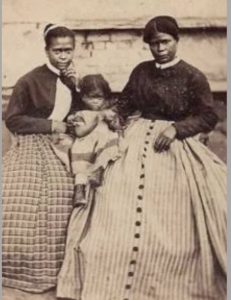Pekin history project honors legacy of former slave
Chronicle Media — June 9, 2023
Nance Legins-Costley and her family. She was a former slave who then lived in Pekin.
Pekin Community High School staff and students were recognized for their class work this past year concerning the history and legacy of Nance Legins-Costley, a historically important Pekin resident and first enslaved individual emancipated by Abraham Lincoln.
This is a multi-disciplinary project, students from creative writing, art, state and local history, psychology, and American government and civics courses found inspiration in Legins-Costley historic story.
All writing and art in was generated by PCHS students.
Pekin Mayor Mary Burress and Tazewell County Clerk and Recorder of Deeds John C. Ackerman hosted a media event on Thursday, June 1, at the Holman Center to honor the students’ and teachers’ work on this project.
The high school, the Pekin Public Library, and the Tazewell County Genealogical & Historical Society will also post on their websites a link to the artwork, poetry, inspirational quotes, and video biography created by the students this past year: https://pchs.my.canva.site/students-celebrate-nance.
This class work was tied into the June 17 dedication in downtown Pekin of the first memorial nationwide to Legins-Costley and her son William Costley.
The dedication is the focus of this year’s Tazewell County Juneteenth Celebration and featured Illinois Supreme Court Justice Lisa Holder White and author Carl Adams as speakers.
The website featuring this collection of class work is now public and now available to inspire the community to attend the Nance Legins-Costley and William Costley Memorial Dedication Event as well as other Central Illinois Juneteenth Events planned around this vital national historical event. Here again is the link to the webpage created by the Pekin Community High School Students: https://pchs.my.canva.site/students-celebrate-nance.
Legins-Costley was born into slavery when Illinois was still a territory. As such, she lived in slavery following Illinois’ statehood and was sold several times before settling in Pekin. At 14, she began legal challenges to her status as a slave, and in 1841 then young attorney Abraham Lincoln took her case before the Illinois Supreme Court, successfully gaining her freedom.
She lived the majority of her life in Pekin, moving to Peoria in old age to live with her daughter. Her gravesite in Moffitt Cemetery was paved over and as such their currently is no monument to her life.
Her eldest son, William Costley, is recognized as the first male enslaved individual emancipated by Abraham Lincoln by the same legal action the secured his mother’s freedom. He later enlisted in the Union Army, was injured in battle in Virginia but returned to his unit, the famed 29th Colored Infantry Regiment, when it was redeployed to Texas.







